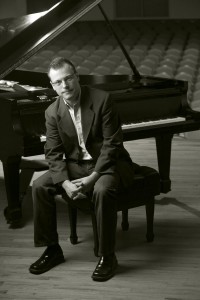By Stephen Brookes • The Washington Post • April 19, 2011
Kaija SaariahoYou knew something interesting was happening at the Corcoran Gallery of Art when clarinetist David Jones swept the music off his stand, pulled a wrinkled sheet of paper out of his pocket and began to furiously wail on his instrument. Violinist Lina Bahn, meanwhile, was reaching over Tobias Werner’s shoulder to play his cello with her bow, while Jenny Lin strummed the strings of her piano with a pearl necklace. Just a normal afternoon, in other words, in the life of the Verge Ensemble, which closed out its 2010-2011 season on Sunday with one of its typically imaginative, playful and up-to-the-minute concerts of new music.
 Jeffrey NytchThat particular piece — a controlled improvisation called “reaLive 2008,” by Verge artistic director Steve Antosca — may have been the most theatrical on the program, but the rest of the fare was just as engaging. Gina Biver’s “The Cellar Door” built on Jungian ideas of unifying the conscious and the unconscious minds, pitting vivid, “human” lines in the cello and piano against a track of manipulated waterphone sounds, unifying the two in a striking climax. Frederick Weck projected video of shifting, amorphous colors for his “video ix” while pianist Lin carved well-defined lines on the piano, and Timothy Beyer presented a piece that was as much poetry as it was music: an electronically manipulated reading of a dramatic text titled “I have so often dreamed of you.”
Jeffrey NytchThat particular piece — a controlled improvisation called “reaLive 2008,” by Verge artistic director Steve Antosca — may have been the most theatrical on the program, but the rest of the fare was just as engaging. Gina Biver’s “The Cellar Door” built on Jungian ideas of unifying the conscious and the unconscious minds, pitting vivid, “human” lines in the cello and piano against a track of manipulated waterphone sounds, unifying the two in a striking climax. Frederick Weck projected video of shifting, amorphous colors for his “video ix” while pianist Lin carved well-defined lines on the piano, and Timothy Beyer presented a piece that was as much poetry as it was music: an electronically manipulated reading of a dramatic text titled “I have so often dreamed of you.”
A technical glitch made it impossible to play the computer track to Kaija Saariaho’s stunning 1988 work “Petals,” but that turned out to be blessing; Tobias Werner played the piece in its original form for solo cello, revealing subtle colors and extraordinary details often lost in the more widely heard version. But the most intriguing piece on the program may have been the world premiere of Jeffrey Nytch’s “Nottorno.” A most vivid and unsettling nocturne, the piece evoked that dreamlike state between waking and sleeping, a surrealistic world where all things are possible and events take on a logic all their own.